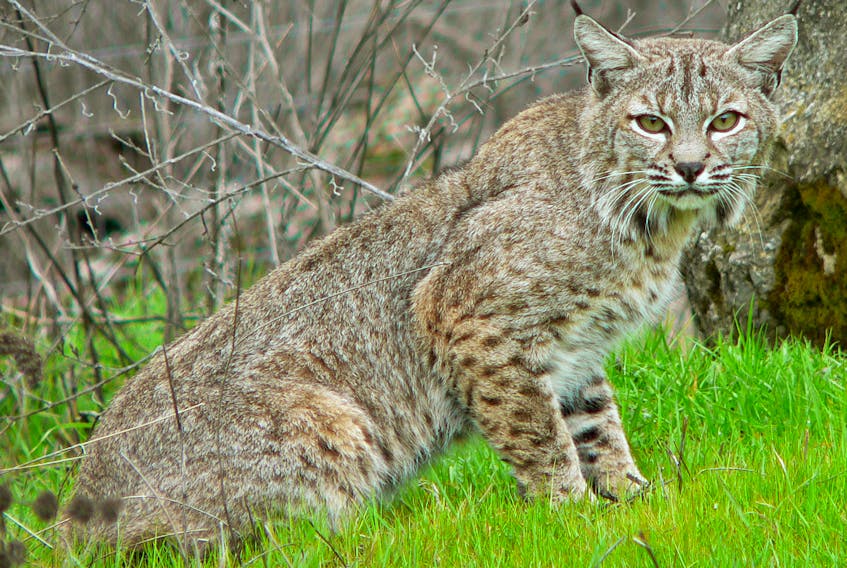Would it surprise you to know that the Bras d’Or Lake Biosphere is the home of three species of wildcats — not including the escaped domestic variety?
They are all very mysterious and probably aware of your presence although you may be blissfully unaware of theirs.
The largest of these wildcats is the cougar (Mi’kmaq: bittaluat) — 76 cm tall and weighing up to 80 kg. There are many reports of cougar sightings in Nova Scotia each year, including in Cape Breton, but no scientific proof of their presence.

According to Nature Canada, cougars were once found all over North America. Their preferred habitat is large tracts of undisturbed forest with abundant prey, preferably white-tailed deer.
The Eastern cougar has been declared extinct by the U.S. Fish and Wildlife Service. According to the Nova Scotia Department of Lands and Forestry, it is officially listed as an endangered species by the Committee on the Status of Endangered Wildlife in Canada and is protected in Nova Scotia.
The other two wildcats of the biosphere are of similar size and can be easily confused.
Our most common wildcat, the bobcat, is non-native. The bobcat is normally a southerly species with a range covering most of the United States and the border regions of Canada. Bobcats (Mi’kmaq: pqajue’wj) weigh about 13 kg and stand about 53 cm tall.
The third species is the native Canada lynx (Mi’kmaq: apuksikn) which is about 65 cm tall, weighing up to 17 kg. The lynx is a snowbelt animal whose range covers most of Canada and Alaska and a few portions of the northern United States.
The biosphere and the rest of Cape Breton Island is significant habitat for the lynx. It is the only part of Nova Scotia where this species can still be found.
Although both species can be found on our island, the normal preferred habitats of the bobcat and lynx tend to keep them physically separated.

In Cape Breton, the bobcat tends to inhabit the low-lying, open areas such as the Boisdale Hills, where there isn’t usually a lot of snow in winter. The lynx is found in the higher, more heavily forested areas of the Cape Breton Highlands, where there is a lot of snow. With a thicker coat and larger, furrier feet, the lynx is better adapted to the snowier areas.
This has been a good winter for our lynx throughout the biosphere. The lynx prefers a steady diet of snowshoe hares and its population will vary as a function of the abundance of this prey. The bobcat likes to dine on snowshoe hares if available but is quite amenable to diet supplements of other small mammals and birds.
So, if you do see a wildcat about three to four times the mass of a large domestic cat, how do you know if it is a bobcat or lynx?
While the bobcat looks very similar to the domestic cat, the lynx looks like a jacked-up sports model. The back legs are longer than the front; the feet are longer; the paws are larger and furrier; the back is arched; there is minimal spotting on its coat and there are long tufts extending from the ears.
Wildcats are very secretive so consider yourself very lucky if you have seen one.
Your glimpse into their world may only be a vision of what they left behind if you know what I mean. That could mean “scat” or droppings which might encourage you to pay closer attention to the ground that you are walking on. It also could mean tracks, which may provide an intriguing bit of detective work for you. The first step is to make sure that you are looking at the tracks of a wildcat rather than, say, a German shepherd or coyote.
The feline’s track will be rounder and will lack any claw impressions. The front of the feline’s heel pads will have two lobes and the rear three compared to the canine’s one at the front of the heel pad and two at the rear.
If you have clear impressions and are sure that a feline left the tracks, you can look for clues about the species of feline. Start with size. Your house cat will leave tracks that are about three to four centimetres long. Cougars will leave tracks that are about twice that with lynx and bobcats somewhere in-between.
Lynx tracks are quite distinctive because of the large amount of fur between the toes. The foot impressions show smaller, less distinct heel and toe pads because the dense foot fur acts a bit like showshoes, stopping the feet from sinking into the deep snow.

If your detective work has convinced you that you have evidence of wildcats in the biosphere, please log photos of tracks, animals or scat in I-Naturalist at https://www.inaturalist.org/, a web-based platform which is very easy to use.
We are learning a lot about our biosphere residents from photos that Bras d’Or watchers are logging on this site.
Dr. Annamarie Hatcher is a consulting ecologist and a board member of the Bras d’Or Lake Biosphere Reserve Association. Information was largely obtained from https://naturecanada.ca and Paul Rezendes' book “Tracking and the Art of Seeing.” Mi’kmaw names were from “The Mi’kmaw bestiary,” curatorial report 103 of the Nova Scotia Museum. To report evidence of wildcats, send the information to https://novascotia.ca/natr/wildlife/habitats/hab-data/habitat-report-form.asp. For more information about the Bras d’Or Lake Biosphere Reserve Association, visit http://blbra.ca/ or go to Facebook, https://www.facebook.com/blbra/.









